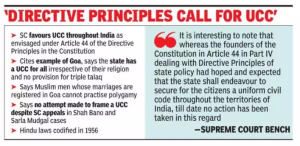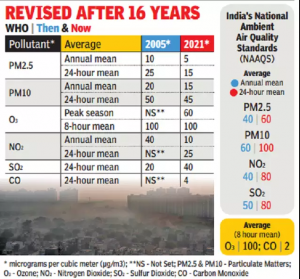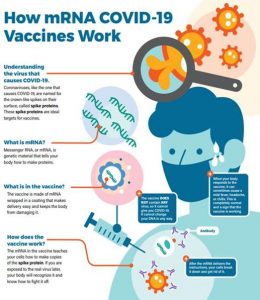THE POLITY AND GOVERNANCE
1. UNIFORM CIVIL CODE OF UTTARAKHAND
THE CONTEXT: Uttarakhand’s CM recently announced, that his government will implement the Uniform Civil Code in the state soon. The state cabinet unanimously approved that a committee of experts will be constituted at the earliest and it will be implemented in the state.
THE EXPLANATION:
The CM has claimed that it will boost equal rights for everyone in the state and enhance social harmony, boost gender justice and strengthen women empowerment.
What is UCC?
- The Uniform Civil Code (UCC) calls for the formulation of one law for India, which would be applicable to all religious communities in matters such as marriage, divorce, inheritance, and adoption.
- The code comes under Article 44 of the Constitution, which lays down that the state shall endeavour to secure a Uniform Civil Code for the citizens throughout the territory of India.
- It is intended to replace the system of fragmented personal laws, which currently govern interpersonal relationships and related matters within different religious communities.
What Do We Have Now?
- Different religious communities in India are currently governed by a system of personal laws, which have been codified over the years through various pieces of legislation.
- These laws largely focus on the following areas: Marriage and divorce Custody and Guardianship Adoption and Maintenance Succession and

- For example, Hindu personal law is codified in four bills: the Hindu Marriage Act, Hindu Succession Act, Hindu Minority and Guardianship Act, and Hindu Adoptions and Maintenance Act. The term ‘Hindu’ also includes Sikhs, Jains and Buddhists for the purpose of these laws
- Muslim personal law is not codified per se, and is based on their religious texts, though certain aspects of these are expressly recognised in India in acts such as the Shariat Application Act and Dissolution of Muslim Marriages Act.
- Christian marriages and divorces are governed by the Indian Christian Marriages Act and the Indian Divorce Act, while Zoroastrians are subject to the Parsi Marriage and Divorce Act.
- Then, there are more ‘secular’ laws, which disregard religion altogether, such as the Special Marriage Act, under which Inter-religion marriages take place, and the Guardians and Wards Act, which establishes the rights and duties of guardians.
- Furthermore, to protect distinct regional identities, the Constitution makes certain exceptions for the states of Assam, Nagaland, Mizoram, Andhra Pradesh and Goa with respect to family law.
- Goa is, at present, the only state in India with a uniform civil code.
- The Portuguese Civil Code of 1867, which continues to be implemented after India annexed the territory in 1961, applies to all Goans, irrespective of their religious or ethnic community.
2. 13 NEW DISTRICTS INAUGURATED IN ANDHRA PRADESH
THE CONTEXT: Andhra Pradesh officially created 13 new districts taking the total number to 26.
THE EXPLANATION:
How are new districts carved?
The power to create new districts or alter or abolish existing districts rests with the State governments. This can either be done through an executive order or by passing a law in the State Assembly. Many States prefer the executive route by simply issuing a notification in the official gazette.
How does it help?
States argue that smaller districts lead to better administration and governance. For example, in 2016, the Assam government issued a notification to upgrade the Majuli sub-division to Majuli district for “administrative expediency”.
Does the Central government have a role to play here?
- The Centre has no role to play in the alteration of districts or the creation of new ones. States are free to decide.
- The Home Ministry comes into the picture when a State wants to change the name of a district or a railway station. The State government’s request is sent to other departments and agencies such as the Ministry of Earth Sciences, Intelligence Bureau, Department of Posts, Geographical Survey of India Sciences and the Railway Ministry seeking clearance. A no-objection certificate may be issued after examining their replies.
THE INTERNATIONAL RELATIONS
3. BUDAPEST MEMORANDUM ON SECURITY ASSURANCES
THE CONTEXT: Budapest Memorandum on Security Assurances refers to three identical political agreements signed at the Organization for Security and Co-operation in Europe (OSCE) conference in Budapest, Hungary in 1994.
THE EXPLANATION:
About the memorandum
The Budapest Memorandum on Security Assurance, signed on December 5, 1994, sealed Ukraine’s membership in the NPT and its status as a non-nuclear country in return for security assurances. The signatories were the presidents of Ukraine, the US , Russia, and the British Prime Minister.
- The signatories of the memorandum agreed to provide security assurances to Belarus, Kazakhstan, and Ukraine in return for their accession to the Treaty on the Non-Proliferation of Nuclear Weapons (NPT).
- It came after the Lisbon Protocol of 1992, which made Ukraine, Belarus, and Kazakhstan parties to the first Strategic Arms Reduction Treaty (START I). It was a treaty signed by the US and the Soviet Union in 1991 to reduce the number of nuclear weapons.
- As a result of the agreements and the memorandum, between 1993 and 1996, Belarus, Kazakhstan and Ukraine gave up their nuclear weapons and became non-nuclear states.
- At that time, Ukraine had the world’s third-largest nuclear arsenal.
Signatories
- The memorandum was originally signed by three nuclear powers: Russia, the USA, and the UK.
- Later, China, and France, who became NPT members in 1992, also became signatories. However, they gave weaker individual assurances in separate documents.
Provisions
Russia, the US, and the UK agreed to the following:
- Respect Belarusian, Kazakh & Ukrainian independence & sovereignty in existing borders.
- Refrain from the threat or the use of force against Belarus, Kazakhstan, and Ukraine.
- Refrain from using economic pressure on Belarus, Kazakhstan, and Ukraine to influence their politics.
- Refrain from the use of nuclear arms against Belarus, Kazakhstan, and Ukraine.
- Seek immediate UN Security Council action to assist Belarus, Kazakhstan, and Ukraine if they “should become a victim of an act of aggression or an object of a threat of aggression in which nuclear weapons are used”.
About OSCE
|
THE ENVIRONMENT, ECOLOGY AND CLIMATE CHANGE
4. 99% OF THE WORLD’S POPULATION IS BREATHING POLLUTED AIR: WHO
THE CONTEXT: According to the data from the UN health agency showed that every corner of the globe is dealing with air pollution, although the problem is much worse in poorer countries. “Almost 100% of the global population is still breathing air that exceeds the standards recommended by the World Health Organization,”
THE EXPLANATION:
- In its previous report four years ago, WHO had already found that over 90% of the global population was affected, but it has since tightened its limits.
- “The evidence base for the harm caused by air pollution has been growing rapidly and points to significant harm caused by even low levels of many air pollutants”.
- WHO’s study provides air quality data from more than 6,000 cities and other settlements across 117 countries — representing around 80 percent of urban settings.
- In addition, WHO used satellite data and mathematical models to determine that air quality is falling short basically everywhere.
- The poorest air quality was found in the eastern Mediterranean and Southeast Asia regions, and Africa.The findings were alarming, it said, and highlighted the need for rapidly curbing fossil fuel use.
WHO’S AIR QUALITY GUIDELINES:
Governments Measures taken:
- Notification of National Ambient Air Quality Standards and sector-specific emission and effluent standards for industries;
- Setting up of monitoring network for assessment of ambient air quality;
- Introduction of cleaner gaseous fuels like CNG, LPG etc and ethanol blending;
- Launching of National Air Quality Index (AQI);
- Leapfrogging from BS-IV to BS-VI standards for vehicles by 1st April 2020;
- Regulating the bursting of pollution-emitting crackers;
- Notification of graded response action plan for Delhi identifying source-wise actions for various levels of air pollution, etc.
- National Clean Air Programme.
THE SCIENCE AND TECHNOLOGY
5. BIOLOGICAL E. TO RECEIVE MRNA VACCINE TECHNOLOGY FROM WHO
THE CONTEXT: Vaccine maker Biological E has been selected to receive mRNA technology from the World Health Organization technology transfer hub.
THE EXPLANATION:
- After examining a number of proposals from India, the WHO’s Advisory Committee on Vaccine Product Development has selected Biological E as a recipient.
- The WHO’s technology transfer hub has the potential to expand manufacturing capacity for other products as well, including treatments, and target other priorities such as malaria, HIV and cancer. The WHO and partners will work with the Indian government and Biological E to put in place training and support for the company to start producing mRNA vaccines.
BACKGROUND:
The COVID-19 pandemic awakened the world to the power of RNA therapies — two of the first vaccines that emerged in late 2020, Pfizer-BioNTech and Moderna, used this technology. At Present, an Indian company is developing an mRNA vaccine from scratch, signalling possibilities of the use of the molecule in a variety of diseases beyond COVID-19.
What are mRNA vaccines and how do they work?
- Most vaccines contain weakened or dead bacteria or viruses. However, scientists have developed a new type of vaccine that uses a molecule called messenger RNA (or mRNA for short) rather than part of an actual bacteria or virus. Messenger RNA is a type of RNA that is necessary for protein production.
- In cells, mRNA uses the information in genes to create a blueprint for making proteins. Once cells finish making a protein, they quickly break down the mRNA. mRNA from vaccines does not enter the nucleus and does not alter DNA.

THE PRELIMS PRACTICE QUESTIONS
QUESTION OF THE DAY
Q1. Consider the following statements about the Jagannath Puri temple:
- It is built by kings of the Pala dynasty
- It is an example of Kalinga Architecture
Which of the statements given above is/are correct?
a) 1 only
b) 2 only
c) Both 1 and 2
d) Neither 1 nor 2
ANSWER FOR 4TH APRIL 2022
Answer: d)
Explanation:
UNEP hosts the secretariats of several multilateral environmental agreements and research bodies, including CBD, The Minamata Convention on Mercury, CMS and CITES.
Spread the Word
